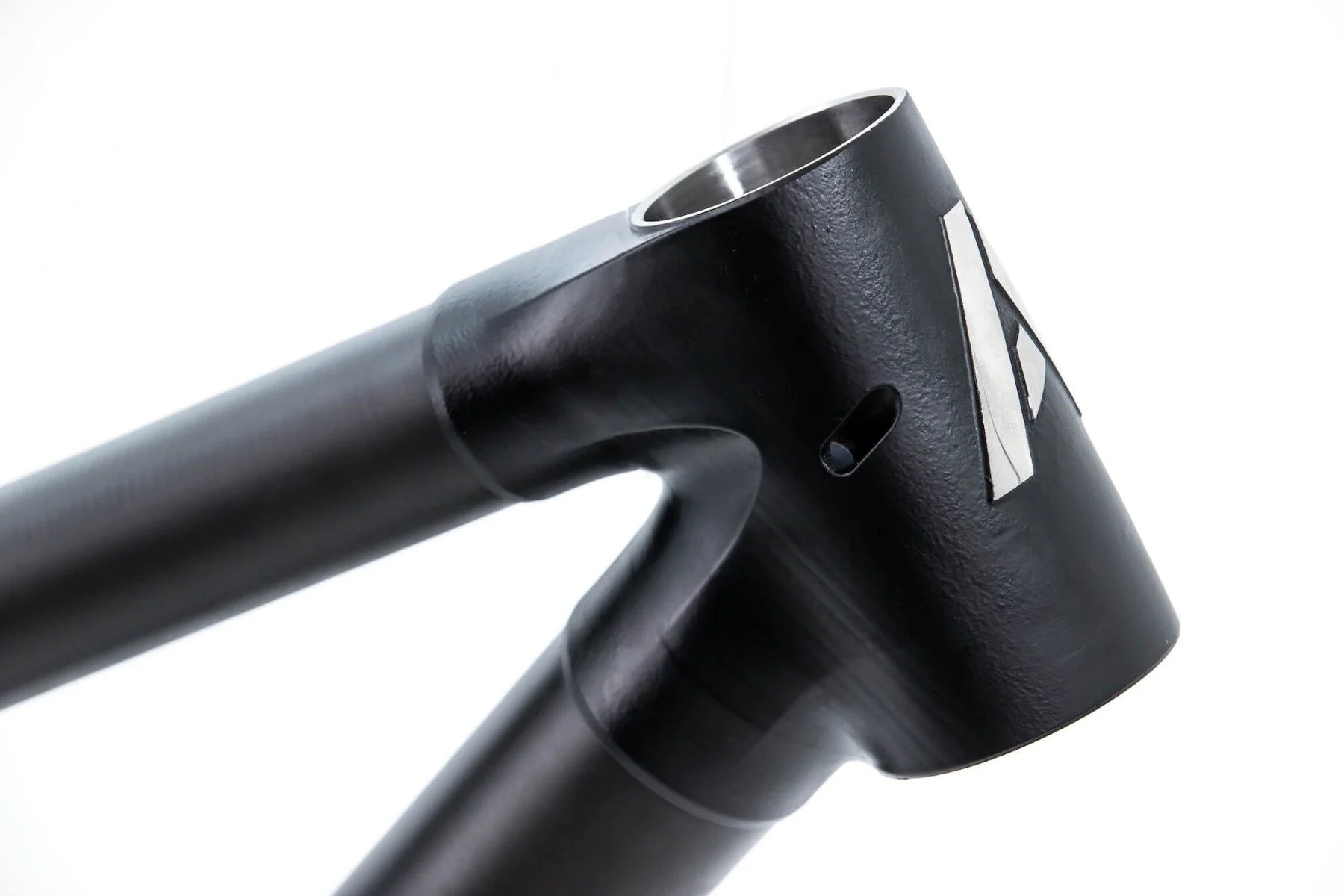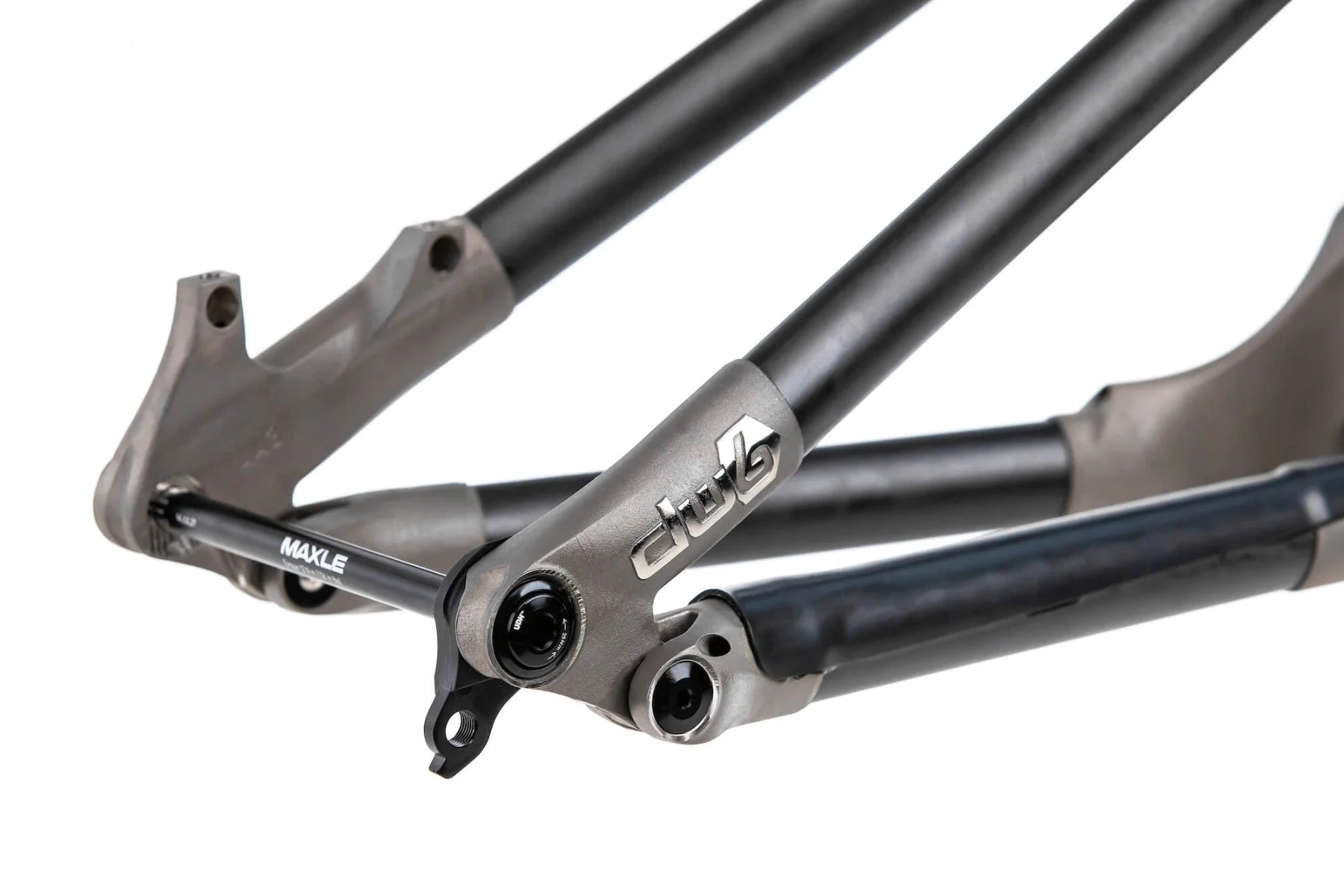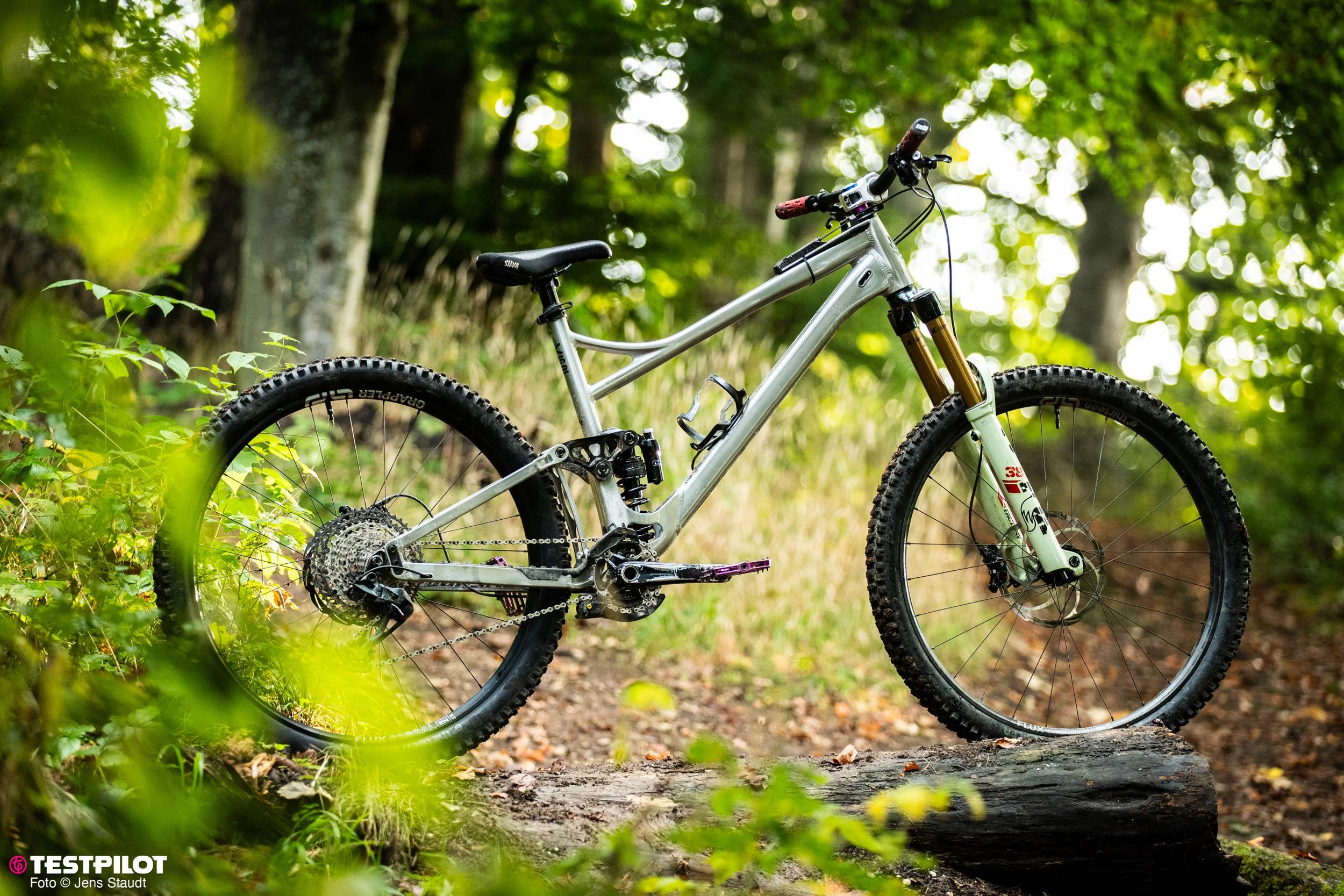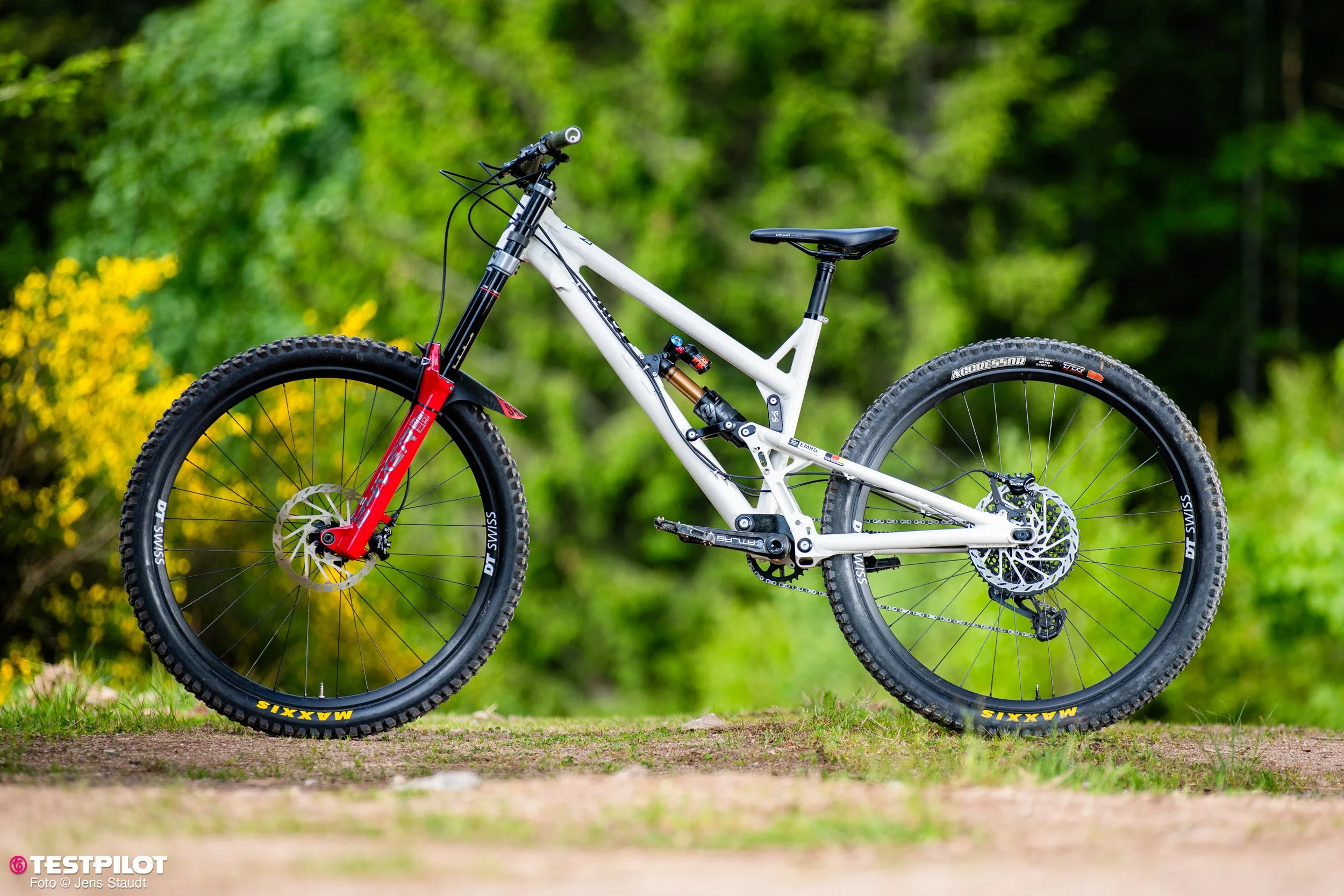Atherton A.150 versus S.150 – Differences. Which bike is better?
Reading time: 5–6 minutes
Last year Atherton bikes expanded their lineup towards a more affordable variant of their unique bikes. Alloy CNC parts are bonded to alloy tubes instead of 3D-printed titanium lugs to carbon. While both bikes share similar DNA, the differences resemble siblings of a family. Same, but different. You can try to make your decision easy on which version is for you by trying to look at the price tag alone. But that is far from what these two bikes are about. Let’s get straight to the frame of the matter. In this article, we will provide you with insights on how the two versions feel on the trail and help you get an idea of which one would fit your riding style.
You want more sophisticated bikes? They all can be found here.
First things first: the nomenclature "A" stands for additive manufacturing, the proper way of saying 3D-printed titanium lugs. "S" stands for subtractive manufacturing, which means CNC’d alloy parts. Both get carbon or alloy tubes, respectively, and everything is bonded together. A fancy way to say glued. But unlike your high school crafts, this bonding material is also used in aerospace applications. These adhesives can withstand way much more torque, and you probably break a frame before you break the bond.
On the aluminum version, Atherton uses custom-profile drawn aluminum tubing cut specifically to length. The lugs and the two-piece rear triangle are machined from a solid plate of 7075 aluminum. Custom tuned to ride feel. So let’s weld them together! Not really. This specific blend has some characteristics making it challenging, and bonding is more common with this. Why go with something so special, while everyone uses weldable aluminum? The 7075 has higher fatigue durability (think aerospace applications). Fancy right? Thinking about what the pros show of what is possible on this bike, you get it. They (and you nerdy biker) want this material.
Bikers are material-driven. We have a ranking of what we consider premium, and naturally, titanium and carbon make the top of the list. By this, the A frame is still the pick over highest grade aluminum. And with great premium comes great sizing responsibility: you get 22 sizes on the Ti-Carbon frame. That’s basically a tailor-made suit. The alloy S version offers a still-impressive 12 sizes, which feels stingy only if you’ve already tasted the luxury of having 21 other options.
Still not satisfied? Want your geo just a bit spicier than what the family has to offer? Custom geometry is on the menu too, if you're going with the titanium version and don’t mind a little extra charge. Because dreams don’t come cheap, but they can come with exactly 63.3747° of head angle and 497.4221mm of reach.
CNC is a widely common manufacturing method, even carbon took over the last couple of years in the premium sector.
Printing the lugs do not provide a finished product. Cleaning them up (by hand) and machining some of them is necessary.
Geometry: Close, but not the same
Geometrically, the two versions are extremely similar. Chainstays grow in length with the frame sizes, and there’s a mere half-degree difference in head angle. Minor tweaks here and there, but unless your last name is Atherton, you have to be a top-level nerd to notice them in a blind back-to-back test on the trail. In the unlikely case that you still can't find the size or version you are looking for, you can get a custom version of the A-series. You may need to get in contact with Atherton for the details.
"Our motivation for the entire S-Range was to bring the learnings from our award-winning halo-range to a more accessible price point." – Rachel Atherton
| Geometry Atherton S.150 | ||||||||||||
| Size | A Reach |
B Seattube |
C Headtube |
D Stack |
E WB |
F HA |
G Eff. STA (*) |
H Act. STA (*) |
I CSL |
J BB Offset |
K BBH |
L Eff. TT |
|---|---|---|---|---|---|---|---|---|---|---|---|---|
| 1 | 415 | 395 | 90 | 618 | 1171 | 64.5 | 77.5 | 74.5 | 430 | -16 | 339 | 554 |
| 2 | 425 | 395 | 90 | 618 | 1181 | 64.5 | 77.5 | 74.5 | 430 | -16 | 339 | 564 |
| 3 | 435 | 395 | 90 | 618 | 1191 | 64.5 | 77.5 | 74.5 | 430 | -16 | 339 | 572 |
| 4 | 445 | 395 | 90 | 618 | 1201 | 64.5 | 77.5 | 74.5 | 430 | -16 | 339 | 582 |
| 5 | 455 | 420 | 100 | 636 | 1220 | 64.5 | 78.5 | 76.0 | 435 | -16 | 339 | 586 |
| 6 | 465 | 420 | 100 | 636 | 1230 | 64.5 | 78.5 | 76.0 | 435 | -16 | 339 | 594 |
| 7 | 475 | 420 | 100 | 636 | 1240 | 64.5 | 78.5 | 76.0 | 435 | -16 | 339 | 604 |
| 8 | 485 | 440 | 100 | 636 | 1250 | 64.5 | 78.5 | 76.0 | 435 | -16 | 339 | 614 |
| 9 | 495 | 440 | 125 | 649 | 1266 | 64.5 | 79.5 | 77.5 | 440 | -16 | 339 | 615 |
| 10 | 505 | 460 | 125 | 649 | 1276 | 64.5 | 79.5 | 77.5 | 440 | -16 | 339 | 625 |
| 11 | 515 | 460 | 125 | 649 | 1286 | 64.5 | 79.5 | 77.5 | 440 | -16 | 339 | 635 |
| 12 | 525 | 480 | 125 | 649 | 1296 | 64.5 | 79.5 | 77.5 | 440 | -16 | 339 | 645 |
| Geometry Atherton A.150 | ||||||||||||
| 1 (410 Low) | 410 | 395 | 100 | 619 | 1167 | 65 | 77 | 69.5 | 433 | -30 | 343 | 553 |
| 2 (420 Low) | 420 | 395 | 100 | 619 | 1177 | 65 | 77 | 69.5 | 433 | -30 | 343 | 563 |
| 3 (430 Low) | 430 | 395 | 100 | 619 | 1187 | 65 | 77 | 69.5 | 433 | -30 | 343 | 573 |
| 4 (440 Low) | 440 | 395 | 100 | 619 | 1197 | 65 | 77 | 69.5 | 433 | -30 | 343 | 583 |
| 5 (450 Low) | 450 | 395 | 110 | 628 | 1216 | 65 | 78 | 71 | 438 | -30 | 343 | 583 |
| 6 (450 Reg) | 450 | 415 | 125 | 641 | 1216 | 65 | 78 | 71 | 438 | -30 | 343 | 586 |
| 7 (460 Low) | 460 | 395 | 110 | 628 | 1226 | 65 | 78 | 71 | 438 | -30 | 343 | 593 |
| 8 (460 Reg) | 460 | 415 | 125 | 641 | 1226 | 65 | 78 | 71 | 438 | -30 | 343 | 596 |
| 9 (470 Low) | 470 | 395 | 110 | 628 | 1236 | 65 | 78 | 71 | 438 | -30 | 343 | 603 |
| 10 (470 Reg) | 470 | 415 | 125 | 641 | 1236 | 65 | 78 | 71 | 438 | -30 | 343 | 606 |
| 11 (480 Low) | 480 | 395 | 110 | 628 | 1246 | 65 | 78 | 71 | 438 | -30 | 343 | 613 |
| 12 (480 Reg) | 480 | 415 | 125 | 641 | 1246 | 65 | 78 | 71 | 438 | -30 | 343 | 616 |
| 13 (490 Reg) | 490 | 415 | 125 | 641 | 1268 | 65 | 78 | 71 | 443 | -30 | 343 | 626 |
| 14 (490 Tall) | 490 | 440 | 125 | 641 | 1268 | 65 | 78 | 71 | 443 | -30 | 343 | 626 |
| 15 (500 Reg) | 500 | 415 | 125 | 641 | 1278 | 65 | 78 | 71 | 443 | -30 | 343 | 636 |
| 16 (500 Tall) | 500 | 440 | 125 | 641 | 1278 | 65 | 79 | 72.4 | 443 | -30 | 343 | 625 |
| 17 (510 Reg) | 510 | 415 | 125 | 641 | 1288 | 65 | 78 | 71 | 443 | -30 | 343 | 646 |
| 18 (510 X-Tall) | 510 | 460 | 125 | 641 | 1288 | 65 | 79 | 72.4 | 443 | -30 | 343 | 635 |
| 19 (520 Tall) | 520 | 440 | 125 | 641 | 1298 | 65 | 78 | 71 | 443 | -30 | 343 | 656 |
| 20 (520 X-Tall) | 520 | 460 | 125 | 641 | 1298 | 65 | 79 | 72.4 | 443 | -30 | 343 | 645 |
| 21 (530 Tall) | 530 | 440 | 125 | 641 | 1308 | 65 | 79 | 72.4 | 443 | -30 | 343 | 655 |
| 22 (530 XX-Tall) | 530 | 475 | 125 | 641 | 1308 | 65 | 79 | 72.4 | 443 | -30 | 343 | 655 |
Suspension: DW4 vs. DW6 – Let the Link Wars Begin
Here’s where things get spicy. Both frames sport DW-link suspension, but the A version goes full DW6, while the S keeps it simpler with DW4. The "A" has more moving bits and bearings (and yes, that usually means more maintenance, but also more tuning ability in the kinematics). Fewer moving parts on the S mean lower costs. It will also come with a subtly different ride character.
So, is more always better? Not necessarily. And again, unless you’re switching between bikes back-to-back with a spreadsheet in hand, you will need to bring plenty of experience to the table to feel the difference.
There is one more link hiding at the bottom bracket area of the DW6 on the left. On the right the DW4 features a kinematic which also is used by other brands.
Ride Impressions: Nerd Mode Activated
We tested both bikes in less-than-perfect trail conditions, so no wild claims here, but both bikes? Absolute rippers.
Let’s start with the S.150 alloy frame. It’s efficient, responsive, and has a knack for returning energy when you pump it through berms or rollers. It doesn’t feel muted or over the top ground hugging; more like it’s ready to party and wants you to bring the watts. Furthermore, it absorbs bigger hits just fine, but you’ll definitely feel more of what’s happening beneath your tires. Some call that feedback. Others call it “more demanding.” Either way, it’s engaging.
The feel of the A.150 titanium-carbon version? Think of the adjective "refined." This bike is a veteran, just like the Atherton family. While riding it, you feel that it has many (MANY) iterations behind itself and is refined to a platinum level. The differences are not only in how the frame feels alone. With the DW6 layout and the fine-tuned chassis, you get a few key advantages:
Less chatter from trail noise
Reduced chain slap and pedal feedback
Better tracking through chunky sections
A calm, composed ride feel
Don't get us wrong here: The difference to the S.150 isn’t night and day; it’s more like finally adjusting a high-end suspension fork just right. You feel the smoothness, the predictability, the dialed-in nature. The bike flows. It encourages rather than demands.












So... Is the A worth the surcharge?
That brings us to the big question. The Gretchenfrage, if you will.
The Ti-Carbon A.150 frameset alone will set you back £4,500. For the same price, you can get a complete S.150 alloy build, ready to ride, basic components, but solid and capable.
So, does the surcharge of the titanium-carbon bike justify the difference in price tag? If you are a reasonable person. But is a person riding a two wheeled vehicle through the forest over roots, rocks, hitting jumps reasonable? Is the A.150 better in subtle, wonderful ways? Absolutely. Will you notice? That depends. Some riders are all about ground feel and rawness; the S will suit them just fine. Others want smoothness, support, and sublime quiet; the A is for them.
But ultimately, we can’t make the decision for you. What’s your riding style? What’s your budget? What gives you that bike-nerd sparkle in the eye?
Titanium and carbon, or good ol’ alloy?
Your call.
What’s next?
We hope to expand on this first impression and provide you a more in depth comparison of both versions from the Atherton lineup. Until then you may listen to the podcast with Dave Weagle to learn about what is even more important than only kinematics and geometry of a frame.
You want more custom bikes?
Autor – Jens Staudt
Height: 191 cm
Weight: 200 lbs (incl ride gear)
Riding style: With his racing background, the lines are planned, even if there is anything bigger in his way. If possible, sections will be jumped over. You should use the entire width of a trail. Others would say - uncompromising.
Motivation: A product should function carefree and for as long as possible. If you have to screw less, you can ride more. He likes to tinker and see how the bike can be optimized.


















